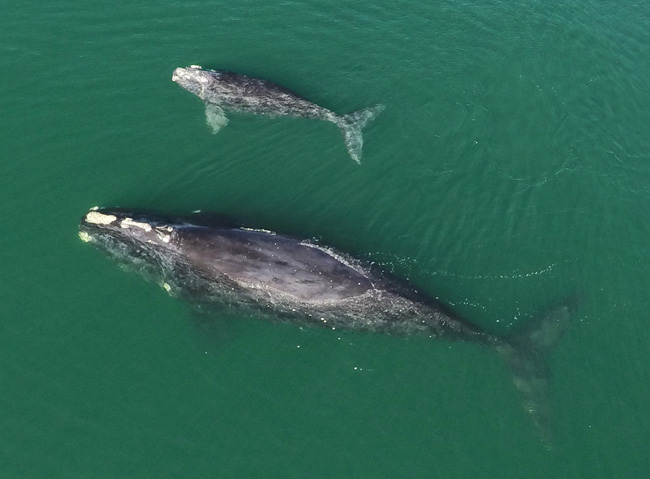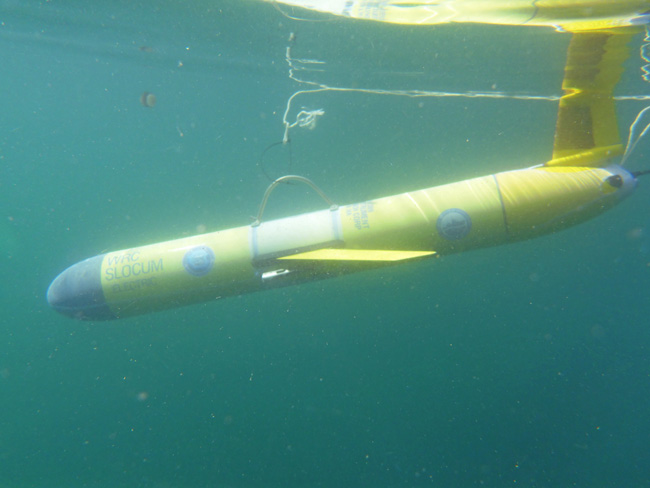Scientists at the University of Georgia Skidaway Institute of Oceanography and the University of South Carolina are using underwater robots and artificial intelligence to help save endangered North Atlantic right whales. The project is led by Skidaway researcher Catherine Edwards and U.S.C. researcher Erin Meyer-Gutbrod.
Scientists believe there are only approximately 340 North Atlantic right whales remaining in the species. The whales are injured and killed from entanglements with fishing gear, lobster pots and other ocean longlines, as well as from being hit by ships.
“One main hazard to them along their migration path is shipping vessel strikes that injure and kill a number of right whales each year,” Edwards said. “Unfortunately, they’re not reproducing fast enough to counteract the harmful effects humans are having on the population. So, each year they decline and decline.”

North Atlantic right whale and calf off of Wassaw Island. Photo courtesy Georgia DNR, taken under NOAA permit 20556.
The whales spend the warm months in areas around the Gulf of Maine, Scotian Shelf and the Gulf of St. Lawrence, before migrating in the winter to their calving grounds off Florida, Georgia and South Carolina to give birth. During this migration, they are susceptible to ship strikes, especially near busy ports like Charleston, South Carolina, and Savannah, Georgia. Larger vessels are supposed to slow to 10 knots during the migration season to allow them to spot and avoid the whales, however recent studies have shown that many vessels don’t comply with this speed limit.
The researchers’ primary goal is to identify and locate migrating whales and alert ships to their proximity. Edwards, Meyer-Gutbrod and their team are using autonomous underwater vehicles, or “gliders,” fitted with hydrophones to listen to the whales’ vocalizations.
Gliders are torpedo-shaped crafts that can be packed with sensors and sent on underwater missions to collect oceanographic data. Equipped with satellite phones, the gliders surface periodically to transmit recorded data to base stations on land. Since they move through the water by adjusting their buoyancy instead of using a traditional motor and propeller, they require very little power and can remain at sea for days or weeks at a time. They are also very quiet, making them a good tool for this type of mission. The team has deployed one glider south of Savannah to detect the whales on their northward trek in the spring and will deploy another north of Charleston during the fall south-bound migration.

A newly launched glide still tethered to the boat.
“Passive acoustic monitoring is a really valuable tool for monitoring baleen whales, such as right whales, because it is often less expensive than visual observations, and data can be collected 24/7 and in bad weather,” Meyer-Gutbrod said. “Gliders have been used with increasing frequency over the past decade to record baleen whale vocalizations and send alerts back in near real-time, however they really haven’t been tested or used in the waters off the southeast U.S. until now.”
The gliders will be complemented by three stationary hydrophone moorings which will also listen for whale vocalizations. The researchers will be able to compare what is heard by each of the instruments.
“I would like to compare the glider-collected acoustic data with archival acoustic data collected with bottom-mounted hydrophones to assess the glider’s detection capabilities in this environment,” Meyer-Gutbrod said.
Picking up whale vocalizations is only part of the solution. Researchers will use a low-frequency detection and classification system developed at Woods Hole Oceanographic Institution to identify the species of baleen whale that made the sounds.
“If a glider hears a sound, it matches it against a library of known whale calls for right whales and other species, and there’s an automated detection that tells the glider, ‘Hey, we just saw something,’” Edwards said.
Meyer-Gutbrod and her students then review and verify that the call is a likely detection based on a small subset of data sent each time that the glider comes to the surface.
The gliders will be positioned to pick up the whale vocalizations and send alerts about every two hours before the whales enter high-traffic areas near the ports of Charleston and Savannah. The detections will be communicated to ship captains by the management and conservation apps Whale Alert (www.whalealert.org) and Whale Map (https://whalemap.org). The researchers hope information on verified whale detections will give the ships the incentive to take protective action, like slowing down to less than 10 knots.
Beyond looking for whales, scientists hope to answer many other research questions about this technique.
“How shallow do the gliders need to get to actually hear the whales? How much background noise do we hear from other things in the environment? Or from human activities? And how much does noise from the glider itself interfere with our ability to hear whale calls?” Edwards said. “And also, how close to you have to be to actually hear them?”
The researchers also want to study recent changes in whale migration patterns. A decline in the food supplies during the summer months has triggered a shift in the North Atlantic right whale’s foraging grounds from the Gulf of Maine northward to the Gulf of St. Lawrence. While surveys have documented this shift, scientists have not yet assessed its impact on winter migration patterns.
The project is funded by a $196,847 grant from the Broad Reach Fund.



It’s exciting to read that this team is using underwater robots to locate whales acoustically so that ships can be alerted and—we hope—motivated to reduce their speed below 10 knots. Has anyone looked to developing underwater ronots that could approach entngled whales, detect the entangling rope, gently approach, encircle only the rope, and cut the rope? The robots would have to be blunt-nosed, fully whale safe, able to navigate toward a whale, and able to very reliably distinguish rope from whale parts. That should be doable with today’s AI if data scientists collaborated with cetaologists to train the AI model on the correct data. If the robots were relatively cheap, especially if one robot could survive long enough to cut multiple ropes off a whale after being deployed by a whale rescue team, it could make the process of rescuing entangled whales much more effective and safe. Obviously the robot would have to be remotely steerable until it was close to the whale, then capable of steering itself toward the ropes. It would need to survive impacts from a thrashing whale without injuring the whale (impossible?) and somehow be impossible for the whale to ingest. This is a crackpot idea, I realize, but maybe reading this will trigger a better idea in a whale expert somewhere.